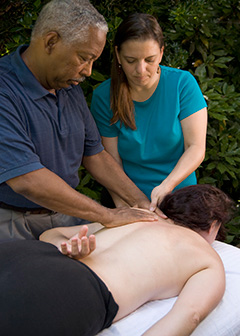Summary

| Quick Facts: Massage Therapists | |
|---|---|
|
$34,900 per year
$16.78 per hour |
|
| Postsecondary non-degree award | |
| None | |
| None | |
| 153,700 | |
| 20% (Faster than average) | |
| 30,900 | |
What Massage Therapists Do
Massage therapists treat clients by using touch to manipulate the soft-tissue muscles of the body. With their touch, therapists relieve pain, rehabilitate injuries, reduce stress, increase relaxation, and aid in the general wellness of clients.
Work Environment
Massage therapists work in an array of settings, both private and public, such as private offices, spas, hospitals, fitness centers, and shopping malls. Some massage therapists also travel to clients’ homes or offices to provide a massage.
How to Become a Massage Therapist
Massage therapists typically complete a postsecondary education program that can require 500 hours or more of study and experience, although standards and requirements vary greatly by state and locality. Most states regulate massage therapy and require massage therapists to have a license or certificate.
Pay
The median annual wage of massage therapists was $34,900 in May 2010.
Job Outlook
Employment of massage therapists is expected to grow by 20 percent from 2010 to 2020, faster than the average for all occupations. Continued growth in the demand for massage services will lead to new openings for massage therapists.
Similar Occupations
Compare the job duties, education, job growth, and pay of massage therapists with similar occupations.
O*NET
O*NET provides comprehensive information on key characteristics of workers and occupations.
Contacts for More Information
Learn more about massage therapists by contacting these additional resources.







